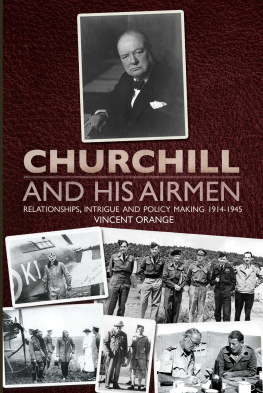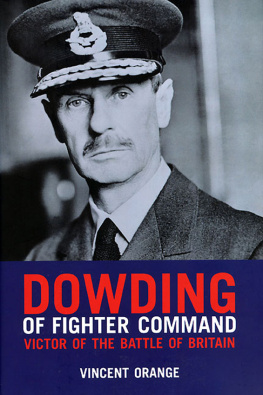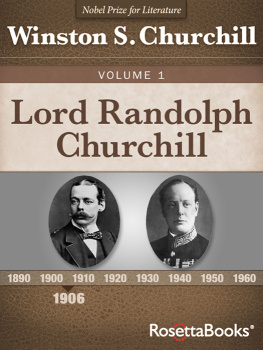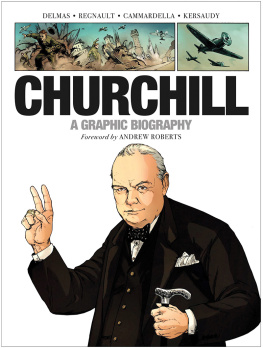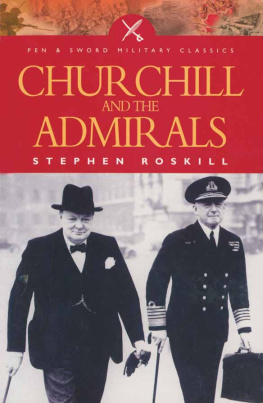Churchill and his Airmen
Published by
Grub Street
4 Rainham Close
London
SW11 6SS
Copyright Grub Street 2013
Copyright text Vincent Orange 2013
British Library Cataloguing in Publication Data
Orange, Vincent, 1935
Churchill and his airmen.
1. Churchill, Winston, 1874-1965Military leadership.
2. Great Britain. Royal Air ForceOfficersHistory
20th century. 3. World War, 1914-1918Aerial operations,
British. 4. World War, 1939-1945Aerial operations,
British.
I. Title
940.44941-dc23
ISBN-13: 9781908117366
All rights reserved. No part of this publication may be
reproduced, stored in a retrieval system, or transmitted in any
form or by any means electronic, mechanical, photocopying,
recording or otherwise, without the prior permission of the
copyright owner.
Cover design by Sarah Driver
Edited by Sophie Campbell
Book design and artwork by:
Roy Platten, Eclipse
Printed and bound by MPG Ltd, Bodmin, Cornwall
Grub Street Publishing only uses
FSC (Forest Stewardship Council) paper for its books.
Contents
Acknowledgements
Above all, to Sandra. I can handle a keyboard, but as for getting my text, pictures and maps to the other side of the world, I depend entirely upon her skills. I am also grateful to my friend Robin Stevens, former Librarian at the University of Canterbury. With the help of his colleagues, Bronwyn Matthews, Tim OSullivan, Rosie Sykes and Dave Clements, they obtained for me essential books and articles from the Library, despite its partial closure as a result of Christchurchs earthquakes.
David McIntyre, at one time head of the History Department, has long been a valued adviser and in particular I have benefitted from his excellent work on the rise and fall of the Singapore naval base. Errol W. Martyn, an expert on RNZAF history, was helpful in the early stages of this work.
Overseas, I am now and always will be grateful to the late Air Commodore Henry Probert, head of the Air Historical Branch in London, his successor, Sebastian Cox, and his right hand man, Sebastian Ritchie, whose book on airborne forces was an essential aide. Across the Atlantic, I have valued for many years the advice and information offered to me by my dear friends, Mrs Yvonne Kinkaid, senior historian at Bolling Air Force Base in Washington DC and Tami Davis Biddle at Duke University of North Carolina, whose book Rhetoric and Reality in Air Warfare has been a constant guide. Last, and by no means least, I am grateful for the support of my publisher, John Davies, who did not fuss when pneumonia prevented me from meeting our original deadline.
Vincent Orange
Christchurch, New Zealand
September
PUBLISHERS NOTE
At the proof reading stage of this book, sadly Professor Vincent Orange passed away. He will be sorely missed. It was his wish that the text be published without footnotes, to make it more easily accessible to the general reader.
For Sandra Rosina Orange, my dear wife

New Worlds to Conquer, 1908-1914
Zeppelins and Aeroplanes
Winston Churchills aviation interests began at the age of thirty-three in 1908 when he read reports of the flight tests carried out by Count Ferdinand von Zeppelins airships in Germany. These tests caused ever-increasing alarm in Britain: neither ships nor armies had threatened her in living memory, but the airship might.
David Lloyd George (Chancellor of the Exchequer) was so disturbed by these reports that he proposed the formation of a coalition government to deal with such an unprecedented danger. Although nothing more useful than cries of alarm followed, Zeppelins all imaginary were regularly reported to be flying over British coasts in years when Europe was more or less at peace.
Shortly after the German alarm sounded in 1908 came another alarm from France, a traditional enemy though currently a suspicious friend. In July 1909 Louis Blriot flew across the Channel from Calais to Dover in barely half an hour. Churchill was among those who realised that practical flying machines (Zeppelins and aeroplanes) would soon affect the age-old conduct of war on land and at sea. He was then president of the Board of Trade and announced that the development of an aviation industry would be filled with immense consequences for everyone at home and abroad. The War Office did not share his excitement glumly referring, in July 1910, to the unwelcome progress of aerial navigation, an opinion with which the Admiralty concurred generally. Nevertheless, as soon as Churchill became First Lord of the Admiralty in October 1911, his fertile mind and vivid imagination turned to recruiting pilots and ground crews and he sought instruction in the art of flying himself.
To describe Churchill as taking a close interest in his work, wrote Peter Rowland, would probably be the understatement of all time. He flung himself into it. He would hold that appointment for three years and seven months: The most memorable of my life, he wrote, long after he had earned enduring fame as Prime Minister during the Second World War.
In the winter of 1912-1913 a wave of Zeppelin mania swept across Britain. Citizens saw them everywhere and in February 1913 Churchill assured the Committee of Imperial Defence that Germanys huge airships had actually flown over parts of eastern England. Could the War Office and/or the Admiralty build their own airships or would it be better to develop aeroplanes capable of challenging these monsters? The War Office merely fretted, but the Admiralty goaded by Churchill began to set up a chain of coastal aerodromes, primarily for working with ships at sea.
John Seely, Under-Secretary of State at the War Office, discussed the formation of an air corps with David Henderson, its designated head, in 1912. What is the best method to pursue, he asked Henderson, in order to do in a week what is generally done in a year? The army and the navy had at that time about nineteen qualified pilots between them, whereas France had about 263, so we are what you might call behind. As for Germany, she would have 180 aeroplanes in the west on the outbreak of war in August 1914.
Early hopes for a unified air service gradually evaporated with the Admiralty determined to keep command of one and the War Office just as anxious to control the other. Air-minded navy officers were keen to develop fighting and bombing aeroplanes, whereas air-minded army officers thought more of developing stable platforms in the sky to observe enemy movements and direct artillery fire. Churchill had at first been greatly impressed by the potential threat of airships if war broke out, but was gradually won over by the much greater potential of the aeroplane.
Two Wings and a School
Demands in newspapers and in Parliament for the government to foster aviation with more enthusiasm had obliged Prime Minister Herbert Asquith, in November 1911, to invite Henderson (Director of Military Training) and an army staff captain, Frederick Sykes, to look into the matter. Both of them had qualified as pilots during that year and in April 1912 Asquith accepted their recommendation that a Royal Flying Corps, comprising an Army Wing and a Naval Wing with a Central Flying School to serve both should be created. Sykes commanded the Army Wing from 1912 to 1914 and Henderson was appointed Director of Military Aeronautics in September 1913. They are the first two in a long line of distinguished airmen who might fairly be called Churchills.


